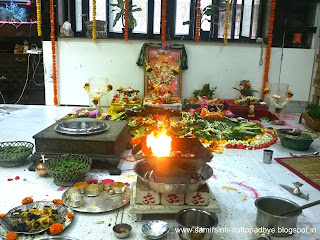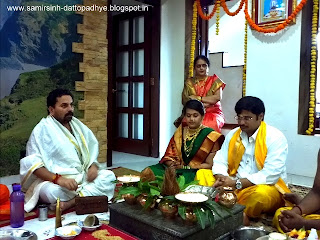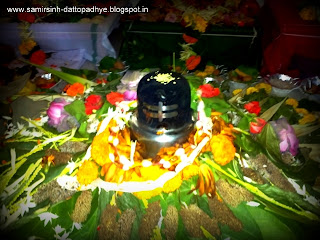Mangalagauri Poojan
On Tuesday, 7th August 2012, we celebrated Dhrutiveera’s Mangalagaur. Handed down by tradition, this ceremony is performed by a newly married woman on any of the Tuesdays’ of the month of Shravana. This is a vrat and she offers it as a prayer for the long and healthy life of her husband as also for the well being of her family. This poojan essentially includes
- The Panchopchare Ganesh Poojan
- The Panchvakya Punyahavaachan
- The Annapurna Poojan
- The Abhishek, Patri Archan, Grah Yadnya and Havan.
The day before Dhrutiveera's Mangalagauri poojan the ladies of the house came together for the preparations. With flowers, garlands and lights they decorated the hall on 7th floor of Happy Home. They made puran (dough made from gram flour) out of which they made diyas (lamps) for the aarti on the following day. For the naivedya (food offered with love to the bhagavanta and then eaten as prasad), Nandaai herself made the panchapakwanna (pancha = five; pakwanna = delicacies or special sweets meant for a special occasion). The ladies even painted and decorated the sup (sifting fan) for the oti bharan sanskar next day. Shakambhariveera, Nishthaveera and Dhrutiveera applied mehendi on their hands.
Dressed in traditional sarees and ornaments like the kolhapuri saaj, belpaantik, vajratik, pohe haar, mohan maala, lakshmi haar, thushi, bugdi, nath, zubaa etc., the women were all set for the occasion. The poojan began around 11:00 am and was performed in presence of four purohits.
Dhrutiveera and Pradyumnasinh sat for the poojan. To begin with they offered the Ganesh poojan that included the Ganpati Padya Poojan, Panchamruta Snaan, Chandan Lepan and Abhishek. After offering flowers and the naivedya they took the blessings of Mothi Aai (Adimata Chandika), Dattabappa, Bapu (Aniruddhasinh), Aai, Dada and all the elders in the family. This was followed by the Panchvakya Punyahavaachan Vidhi. Dhrutiveera and Nishthaveera performed the Mukhyadevata Poojan i.e. the Annapurna Poojan which included the Panchamruta Snaan, the Dughda Snaan, the Ghrita Snaan, the Dadhi Snaan, the Sharkara Snaan, the Madhu Snaan, the Chandan-gandha Snaan, the Sugandhit Jala Snaan, the Ganga Jala Snaan, the Phala Rasa Snaan, the Haridra Lepan, The Shuddhodaka Snaan, Chandan Lepan and lastly the Abhishek. The Shree Sukta accompanied the Abhishek. Flowers were offered and then the naivedya following which were offered 16 types of leaves (jai, jui, mogra, parijatak, tagar, kaner, ananta, shami, aghada, durva, dhotra, kamal, rui, palas, chafa and maaka) as also flowers to the Shiva Linga.
Pradyumnasinh and Dhrutiveera performed the Havan. A continuous offering of ghee, rice (akshata), til and bilva leaves was made in the Havan as the following mantra was chanted 108 times along with it; "Hrim gaurimimaya namah swaha"
Now it was time to offer the Mahanaivedya to the Pradhan Devata. Dhrutiveera and Nishthaveera did the aarti, thus completing the poojan ceremony.
The Vaayandaan Vidhi :- This vidhi (sacred ritual) was performed by Pradyumansinh, Dhrutiveera and Nishthaveera. This includes giving daan to the purohits and Oti Bharan Sanskar of their wives. This oti includes 4 items viz. anna(food), vastra(clothing), phal(fruits) and dakshina (money).
Nandaai did the oti bharan sanskar of Shakambhariveera, Nishthaveera and Dhrutiveera. Dhrutiveera and Nishthaveera then served food to the purohits and their family after which all the family members had their lunch.
The Yajmaan’s Diet :- The Yajmaan is the one who performs the pooja. The Yajmaan’s diet essentially consists of cow milk, milk products, sweets and fruits.That was where the afternoon session ended.
After a short nap of 10 minutes the ladies geared up for the evening session that began around 7:30. To begin with, Nandaai did the Katha Vaachan. The katha was of course about the Mangalagauri Vrat and poojan. The Katha Vaachan was followed by Haldikunku ceremony and gifts were then given to ladies. The session that followed was marked by traditional Mangalagauri games like various types of fugdi (normal fugdi, eka hatachi fugdi, trifula fugdi, chaufula fugdi, danda fugdi, kersuni fugdi, bas fugdi), jhimma, gathoda, hodi, gof, savticha bhandan, kandan musal fugdi, jata fugdi, kamal chakra etc. The ladies sang traditional songs and recited ukhanas (a poetic verse that weaves in the husband’s name). Ladies of all age groups participated in the games. This session went on until the early hours of the morning – right up to 3:00 a.m.
The Visarjan Vidhi, offering the naivedya (curd rice) and the aarti followed. All the ladies chanted Shubhankara Stavanam, Ashubhanashini Stavanam and Devi Apradh Kshamapan Stotra. All the ladies then had dinner together and took the Prasad (curd rice and diyas made of puran).



